Diffusion Maximum Correntropy Criterion Based Robust Spectrum Sensing in Non-Gaussian Noise Environments
Abstract
:1. Introduction
2. Signal Model and Non-Gaussian Noise Model
2.1. Signal Model
2.2. Non-Gaussian Noise Model
3. Brief Background of the Maximum Correntropy Criterion
4. Distributed Diffusion Maximum Correntropy Criterion-Based Power Estimation and Spectrum Detection
4.1. Derivation of the Distributed DMCC-Based Power Estimation Algorithm
4.2. ATC DMCC-Based Power Estimation
4.3. ATC DMCC-Based Robust Spectrum Sensing
| Algorithm 1 ATC DMCC-Based Robust Spectrum Sensing. |
| Start with for each CU. Choose proper coefficients , and . |
| for every time instant do |
| for every CU , do |
| 1. Power estimation: |
| Adaption: |
| Combination: |
| 2. Detection decision: |
| : or : |
| The threshold is described in detail in Subsection 5.3. |
| end for |
| end for |
5. Performance Analysis
5.1. Mean Performance
5.2. Variance Performance
5.3. Detection Performance Analysis
6. Simulation Results
6.1. Performance of Power Estimation Comparison among the New Method and Other Algorithms
6.2. Probability of Detection Comparison among ATC DMCC and ATC DLMS
6.3. Probability of Detection of ATC DMCC with Different Network Sizes
7. Conclusions
Acknowledgments
Author Contributions
Conflicts of Interest
References
- Mitola, J.; Maguire, G.Q. Cognitive radio: Making software radios more personal. IEEE Pers. Commun. 1999, 6, 13–18. [Google Scholar] [CrossRef]
- Haykin, S. Cognitive radio: Brain-empowered wireless communications. IEEE J. Sel. Areas Commun. 2005, 23, 201–220. [Google Scholar] [CrossRef]
- Mitola, J. Cognitive radio architecture evolution. Proc. IEEE 2009, 97, 626–641. [Google Scholar] [CrossRef]
- Digham, F.F.; Alouini, M.S.; Simon, M.K. On the Energy Detection of Unknown Signals Over Fading Channels. IEEE Trans. Commun. 2007, 55, 21–24. [Google Scholar] [CrossRef]
- Ma, L.; Li, Y.; Demir, A. Matched filtering assisted energy detection for sensing weak primary user signals. In Proceedings of the IEEE International Conference on Acoustics, Speech and Signal Processing, Kyoto, Japan, 25–30 March 2012; pp. 3149–3152. [Google Scholar]
- Kim, K.; Akbar, I.A.; Bae, K.K.; Bae, K.K.; Um, J.; Spooner, C.M.; Reed, J.H. Cyclostationary Approaches to Signal Detection and Classification in Cognitive Radio. In Proceedings of the IEEE International Symposium on New Frontiers in Dynamic Spectrum Access Networks, Dublin, Ireland, 18–20 April 2007; pp. 212–215. [Google Scholar]
- Akyildiz, I.F.; Lo, B.F.; Balakrishnan, R. Cooperative spectrum sensing in cognitive radio networks: A survey. Phys. Commun. 2011, 4, 40–62. [Google Scholar] [CrossRef]
- Yucek, T.; Arslan, H. A survey of spectrum sensing algorithms for cognitive radio applications. IEEE Commun. Surv. Tutor. 2009, 11, 116–130. [Google Scholar] [CrossRef]
- Letaief, K.B.; Zhang, W. Cooperative Communications for Cognitive Radio Networks. Proc. IEEE 2009, 97, 878–893. [Google Scholar] [CrossRef]
- Xu, X.; Qu, H.; Zhao, J.; Chen, B. Cooperative spectrum sensing in cognitive radio networks with kernel least mean square. In Proceedings of the IEEE International Conference on Information Science and Technology, Changsha, China, 24–26 April 2015; pp. 574–578. [Google Scholar]
- Rodger, J.A. Toward reducing failure risk in an integrated vehicle health maintenance system: A fuzzy multi-sensor data fusion Kalman filter approach for IVHMS. Expert Syst. Appl. 2012, 39, 9821–9836. [Google Scholar] [CrossRef]
- Thuc, K.X.; Insoo, K. Cooperative spectrum sensing using Kalman filter based adaptive fuzzy system for cognitive radio networks. Ksii Trans. Internet Inf. Syst. 2012, 6, 287–304. [Google Scholar]
- Mishra, S.M.; Sahai, A.; Brodersen, R.W. Cooperative Sensing among Cognitive Radios. In Proceedings of the IEEE International Conference on Communications, London, UK, 8–12 June 2015; pp. 1658–1663. [Google Scholar]
- Li, Z.; Yu, R.F.; Huang, M. A Distributed Consensus-Based Cooperative Spectrum-Sensing Scheme in Cognitive Radios. IEEE Trans. Veh. Technol. 2010, 59, 383–393. [Google Scholar]
- Zhang, W.; Guo, Y.; Liu, H.; Chen, Y.; Wang, Z.; Mitola, J. Distributed consensus-based weight design for cooperative spectrum sensing. IEEE Trans. Parallel Distrib. Syst. 2015, 26, 54–64. [Google Scholar] [CrossRef] [Green Version]
- Wu, R. Distributed spectrum sensing using belief propagation framework. In Proceedings of the IEEE International Inter-Disciplinary Conference on Cognitive Methods in Situation Awareness and Decision Support, San Antonio, TX, USA, 3–6 March 2014; pp. 137–143. [Google Scholar]
- Ainomae, A.; Trump, T.; Bengtsson, M. CTA diffusion based recursive energy detection. In Proceedings of the Latest Trends in Circuits, System, Signal Processing and Automatic Control, Salerno, Italy, 3–5 June 2014; pp. 38–47. [Google Scholar]
- Ainomae, A.; Trump, T.; Bengtsson, M. Distributed diffusion LMS based energy detection. In Proceedings of the International Congress on Ultra Modern Telecommunications and Control Systems and Workshops, St. Perterburg, Russia, 6–8 October 2014; pp. 176–183. [Google Scholar]
- Ainomae, A.; Trump, T.; Bengtsson, M. Distributed largest eigenvalue detection. In Proceedings of the IEEE International Conference on Acoustics, Speech and Signal Processing, New Orleans, LA, USA, 5–9 March 2017; pp. 3519–3523. [Google Scholar]
- Middleton, D. Non-Gaussian noise models in signal processing for telecommunications: New methods and results for class A and class B noise models. IEEE Trans. Inf. Theory 1999, 45, 1129–1149. [Google Scholar] [CrossRef]
- Blackard, K.L.; Rappaport, T.S.; Bostian, C.W. Measurements and models of radio frequency impulsive noise for indoor wireless communications. IEEE J. Sel. Areas Commun. 1993, 11, 991–1001. [Google Scholar] [CrossRef]
- Sanchez, M.G.; De Haro, L.; Ramon, M.C.; Mansilla, A.; Ortega, C.M.; Oliver, D. Impulsive noise measurements and characterization in a UHF digital TV channel. IEEE Trans. Electromagn. Compat. 1999, 41, 124–136. [Google Scholar] [CrossRef]
- Nassar, M.; Gulati, K.; Sujeeth, A.K.; Aghasadeghi, N.; Evans, B.L.; Tinsley, K.R. Mitigating near-field interference in laptop embedded wireless transceivers. In Proceedings of the IEEE International Conference on Acoustics, Speech and Signal Processing, Las Vegas, NV, USA, 31 March–4 April 2008; pp. 1–12. [Google Scholar]
- Zhu, X.; Zhu, Y.; Bao, Y.; Zhu, W.; Zhu, W. A pth order moment based spectrum sensing for cognitive radio in the presence of independent or weakly correlated Laplace noise. Signal Process. 2017, 173, 109–123. [Google Scholar] [CrossRef]
- Margoosian, A.; Abouei, J.; Plataniotis, K.N. An accurate kernelized energy detection in Gaussian and non-Gaussian/impulsive noises. IEEE Trans. Signal Process. 2015, 63, 5621–5636. [Google Scholar] [CrossRef]
- Karimzadeh, M.; Rabiei, A.M.; Olfat, A. Soft-limited polarity-coincidence-array spectrum sensing in the presence of non-Gaussian noise. IEEE Trans. Veh. Technol. 2017, 66, 1418–1427. [Google Scholar] [CrossRef]
- Zhu, X.; Champagne, B.; Zhu, W.P. Rao test based cooperative spectrum sensing for cognitive radios in non-Gaussian noise. Signal Process. 2014, 97, 183–194. [Google Scholar] [CrossRef]
- Liu, W.; Pokharel, P.P.; Principe, J.C. Correntropy: Properties and applications in non-Gaussian signal processing. IEEE Trans. Signal Process. 2007, 55, 5286–5298. [Google Scholar] [CrossRef]
- Chen, B.; Wang, J.; Zhao, H.; Zheng, N.; Principe, J.C. Convergence of a fixed-point algorithm under maximum correntropy criterion. IEEE Signal Process. Lett. 2015, 22, 1723–1727. [Google Scholar] [CrossRef]
- Ma, W.; Chen, B.; Duan, J.; Zhao, H. Diffusion maximum correntropy criterion algorithms for robust distributed estimation. Digit. Signal Process. 2016, 58, 10–19. [Google Scholar] [CrossRef]
- Panigrahi, T.; Panda, G.; Mulgrew, B. Error saturation nonlinearities for robust incremental LMS over wireless sensor networks. ACM Trans. Sens. Netw. 2014, 11, 1–20. [Google Scholar] [CrossRef]
- Liu, W.; Pokharel, P.P.; Principe, J.C. The kernel least-mean-square algorithm. IEEE Trans. Signal Process. 2008, 56, 543–554. [Google Scholar] [CrossRef]
- Lopes, C.G.; Sayed, A.H. Diffusion least-mean squares over adaptive networks: Formulation and performance analysis. IEEE Trans. Signal Process. 2008, 56, 3122–3136. [Google Scholar] [CrossRef]
- Takahashi, N.; Yamada, I.; Sayed, A.H. Diffusion least-mean squares with adaptive combiners: Formulation and performance analysis. IEEE Trans. Signal Process. 2010, 58, 4795–4810. [Google Scholar] [CrossRef]
- Papoulis, A.; Pillai, S. Probability, Random Variables and Stochastic Processes, 4th ed.; McGraw Hill: New York, NY, USA, 2002. [Google Scholar]
- Billingsley, P. Probability and Measure, 3rd ed.; Wiley: New York, NY, USA, 1995. [Google Scholar]
- Blum, R.S. Necessary conditions for optimum distributed sensor detectors under the Neyman-Pearson criterion. IEEE Trans. Inf. Theory 1996, 42, 990–994. [Google Scholar] [CrossRef]
- Sayed, A.H. Diffusion adaptation over networks. Acad. Press Libr. Signal Process. 2013, arXiv:1205.42203, 323–453. [Google Scholar]

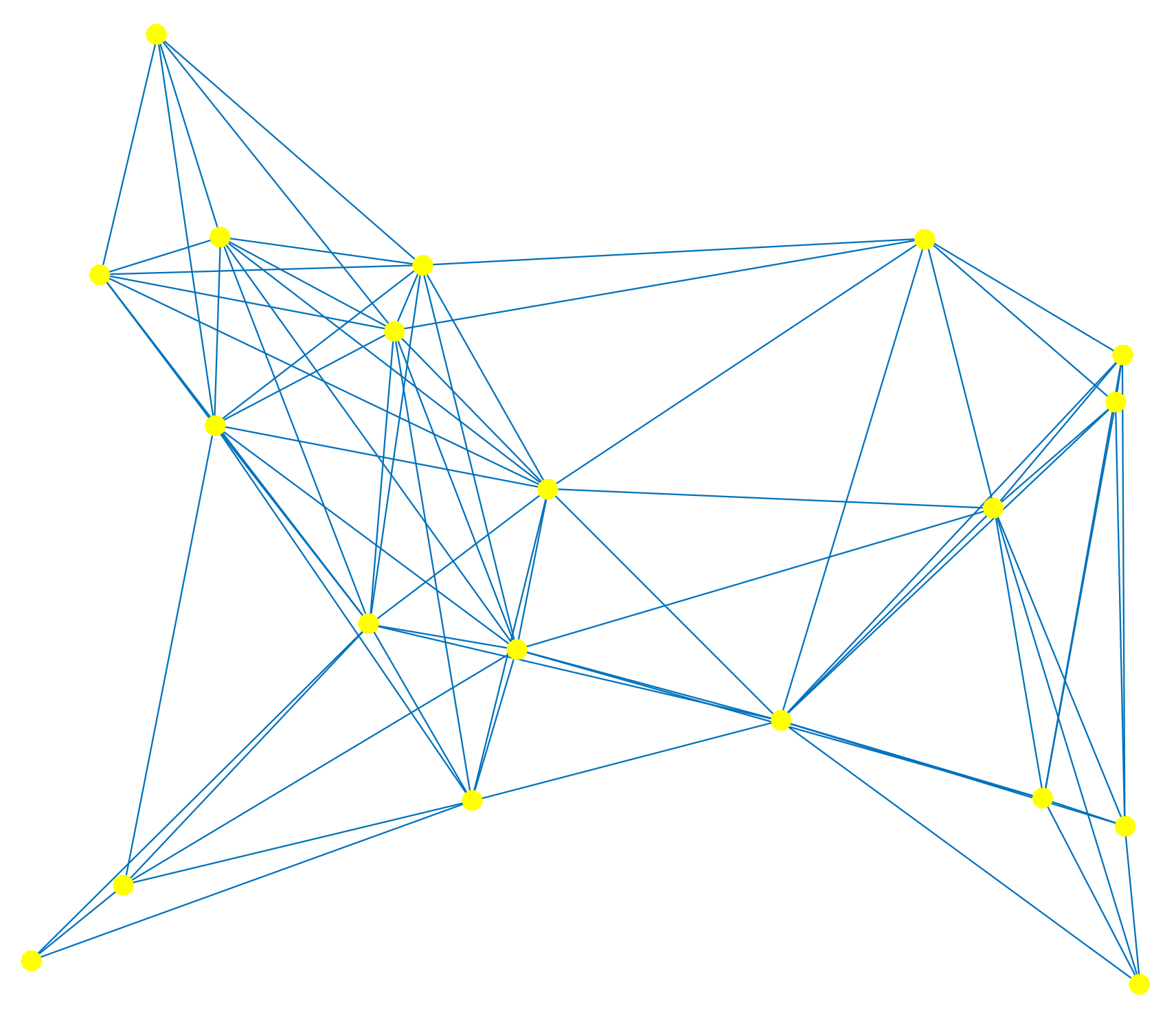
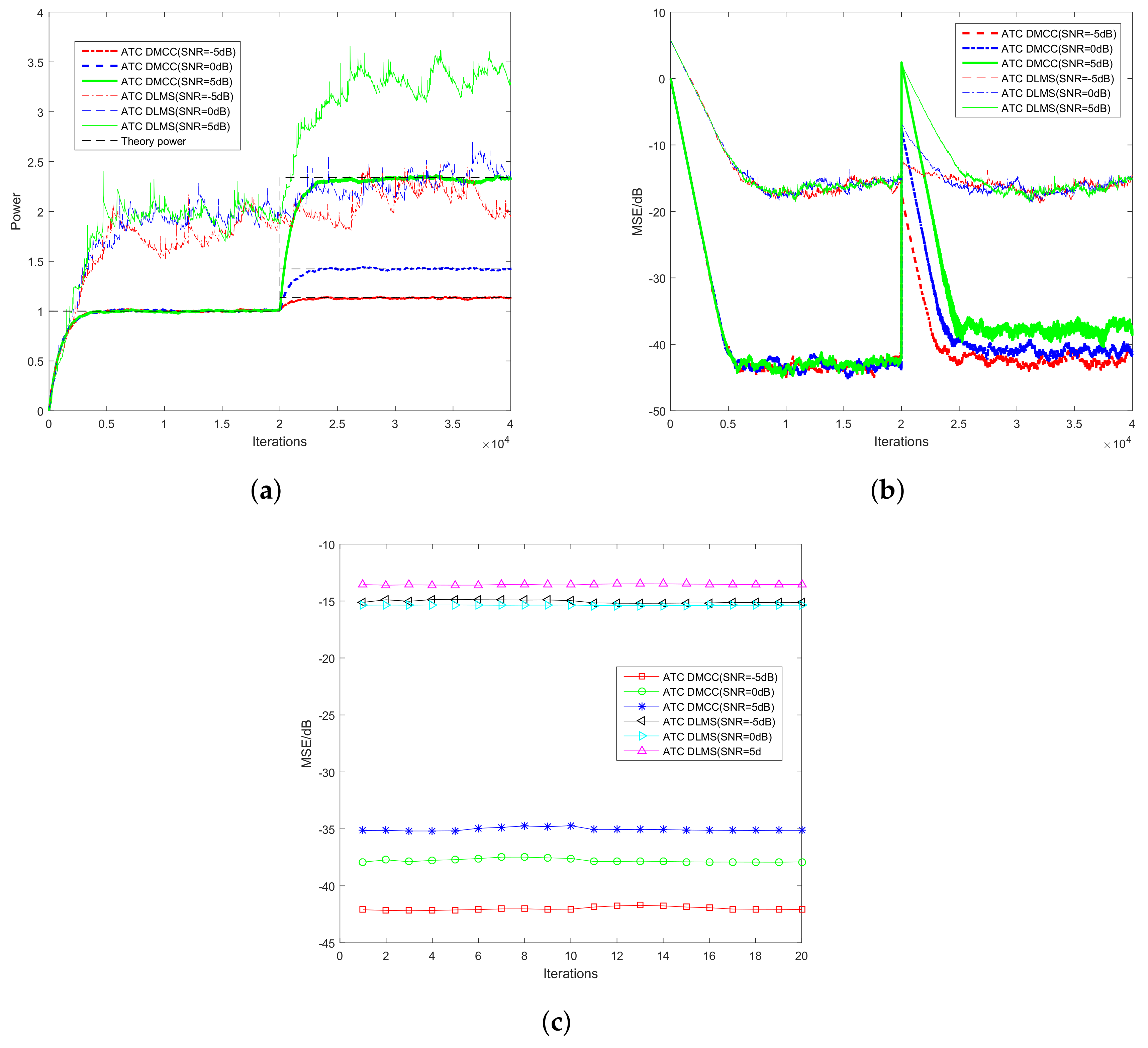
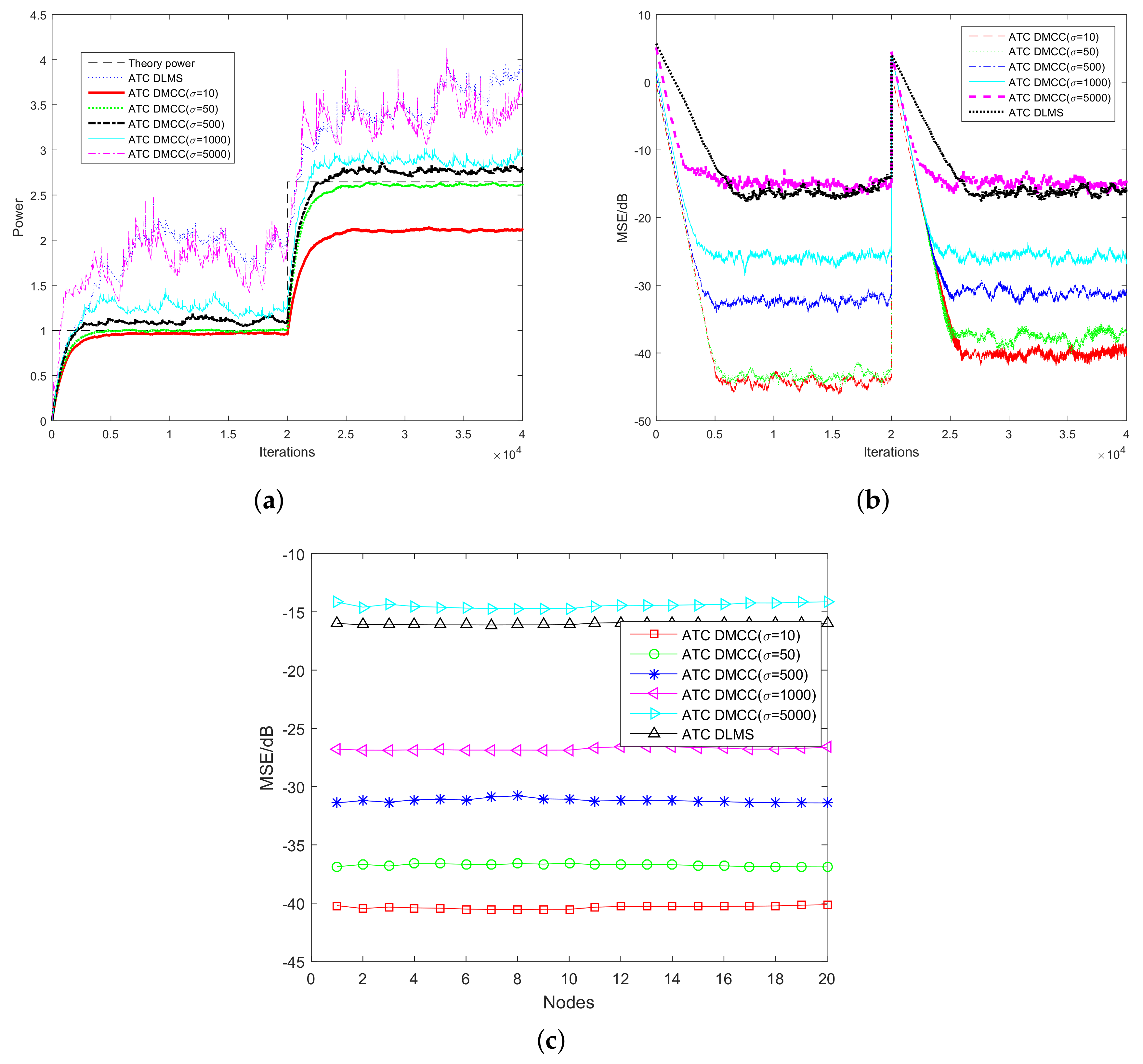
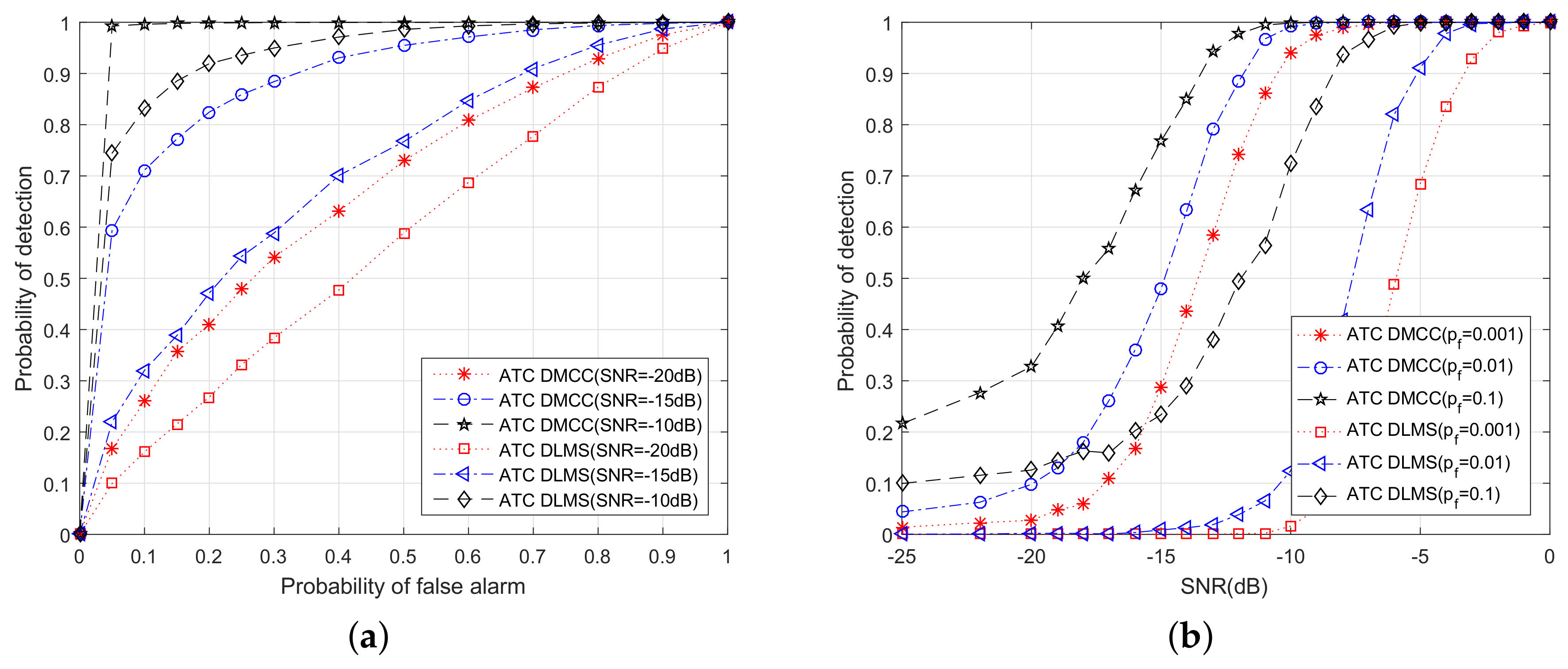
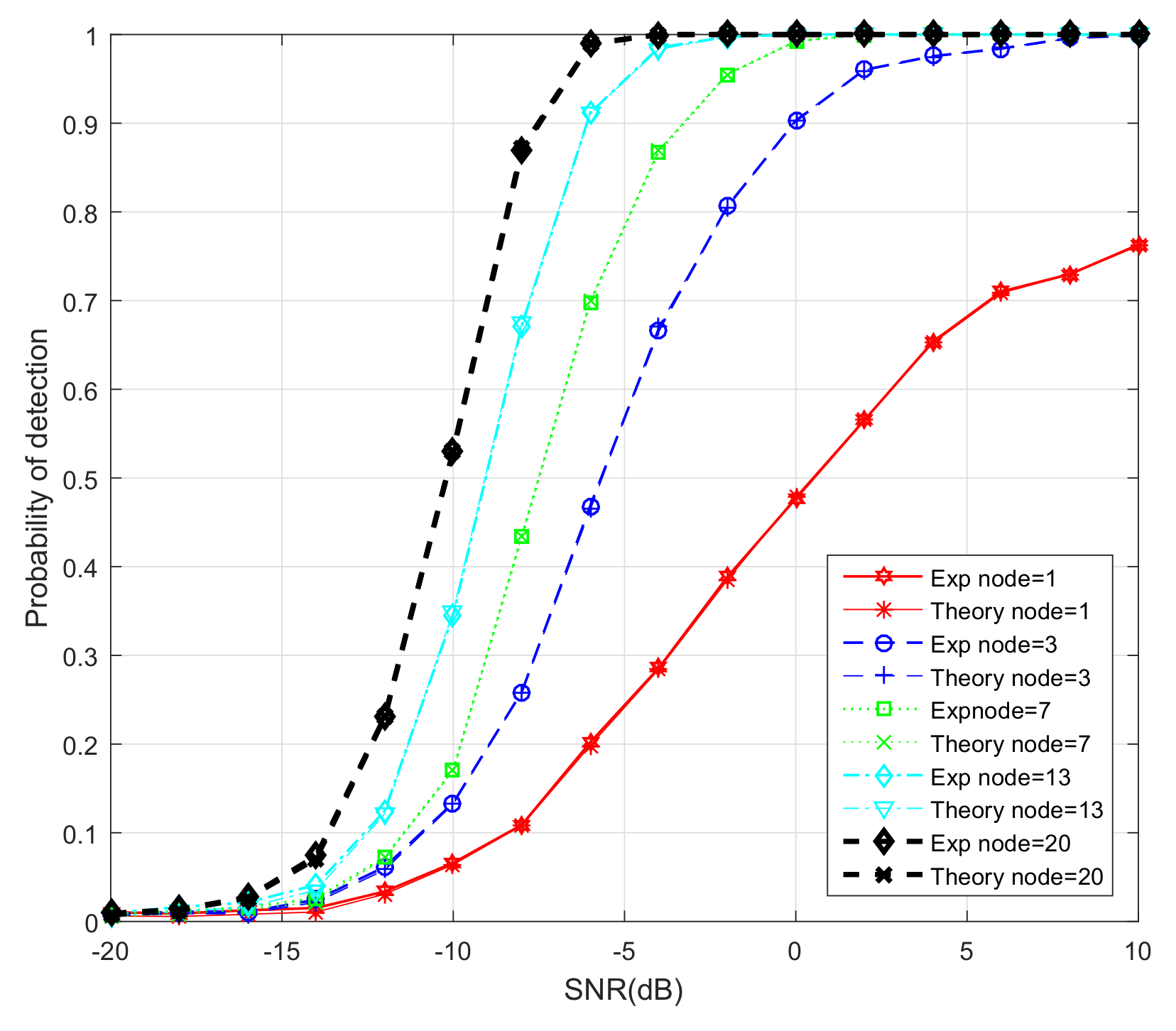
© 2018 by the authors. Licensee MDPI, Basel, Switzerland. This article is an open access article distributed under the terms and conditions of the Creative Commons Attribution (CC BY) license (http://creativecommons.org/licenses/by/4.0/).
Share and Cite
Xu, X.; Qu, H.; Zhao, J.; Yan, F.; Wang, W. Diffusion Maximum Correntropy Criterion Based Robust Spectrum Sensing in Non-Gaussian Noise Environments. Entropy 2018, 20, 246. https://doi.org/10.3390/e20040246
Xu X, Qu H, Zhao J, Yan F, Wang W. Diffusion Maximum Correntropy Criterion Based Robust Spectrum Sensing in Non-Gaussian Noise Environments. Entropy. 2018; 20(4):246. https://doi.org/10.3390/e20040246
Chicago/Turabian StyleXu, Xiguang, Hua Qu, Jihong Zhao, Feiyu Yan, and Weihua Wang. 2018. "Diffusion Maximum Correntropy Criterion Based Robust Spectrum Sensing in Non-Gaussian Noise Environments" Entropy 20, no. 4: 246. https://doi.org/10.3390/e20040246




